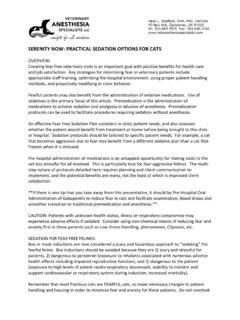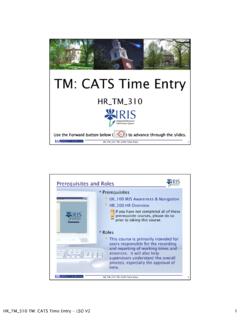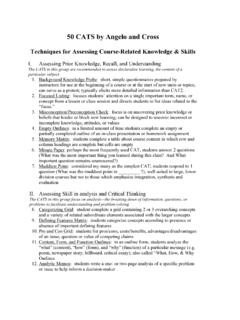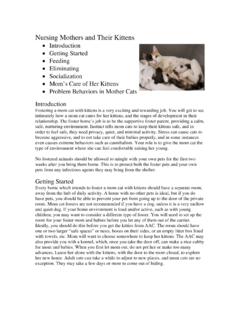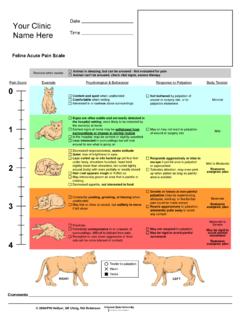Transcription of Pottenger's Cats A Study in Nutrition
1 Book review by Pat McKay Pottenger's Cats A Study in Nutrition Francis M pottenger , Jr, MD Francis pottenger , Jr, MD, has given the cat world one of the best books available in the Study of carnivore's Nutrition . Between the years of 1932 and 1942, he conducted a feeding experiment to determine the effects of heat-processed food on 900 cats. I have to admit I don't like the reason he was doing the Study , because it involved adrenalectomies (surgical removal of the adrenal glands) for use in standardizing the hormone content of the adrenal extract he was making. However, the Study tells so much about carnivorous cats and their need for raw food that as long as the Study has already been done, let's now make this information useful for cats.
2 Most of what I have written in this article/review is verbatim from his book. The complete 123 page book is available from the Price- pottenger Nutrition Foundation for $ The cats in the Study were kept in large outdoor pens overlooking the San Gabriel Valley in California, so the weather was moderate for the cats. Each pen had an open air enclosure 12 feet long, 6 feet wide, and 7 feet high which was screened by chicken-wire so the cats had adequate exposure to the sun. A trench 18 inches deep was dug in each enclosure and filled with freshly washed sand. A roofed area approximately 4 feet deep with a wooden floor and bedding extended from the back of each pen to provide shelter for the animals during inclement weather.
3 All animals were subject to the same routine procedures. Each cat had its own clinical chart and notes were kept through his/her life. At the end of ten years, 600 out of 900 cats studied had complete, recorded health histories. GENERAL OBSERVATIONS RAW MEAT GROUP The cats fed a diet of 2/3 raw meat, 1/3 raw milk, and cod liver oil show striking uniformity in their sizes and their skeletal developments. >From generation to generation they maintain a regular, broad face with prominent malar (pertaining to the cheek or cheek bone) and orbital arches, adequate nasal cavities, broad dental arches, and regular dentition.
4 The configuration of the female skull is different from the male skull, and each sex maintains his/her distinct anatomical features. The membranes are firm and of good, pink color with no evidence of infection or degenerative change. Tissue tone is excellent, and the fur is of good quality with very little shedding noted. In the older cats, particularly the males, engaging in fighting, the incisors are often missing, but inflammation and disease of the gums is seldom seen. The calcium and phosphorus content of their femurs remains consistent, and their internal organs show full development and normal function.
5 Over their life spans, they prove resistant to infections, to fleas, and to various other parasites, and show no signs of allergies. In general, they are gregarious, friendly, and predictable in their behavior patterns, and when thrown or dropped as much as six feet to test their coordination, they always land on their feet and come back for more play. These cats reproduce one homogeneous generation after another with the average weight of the kittens at birth being 119 grams. Miscarriages are rare, and the litters average five kittens with the mother cat nursing her young without difficulty. COOKED MEAT GROUP The cats fed a diet of 2/3 cooked meat, 1/3 raw milk, and cod liver oil reproduce a heterogeneous strain of kittens, each kitten in a litter being different in size and skeletal pattern.
6 When comparing the changes in configuration found in their x-rays, there are almost as many variations in the facial and dental structures of the second and third generation cooked-meat fed animals as there are animals. Evidence of deficiencies is written so plainly on their faces that with a little training, any observer can be almost certain that a given cat has been subjected to a deficient diet or that it comes from a line of cats that has suffered from deficient Nutrition . The long bones of cooked-meat cats tend to increase in length and decrease in diameter with the hind legs commonly increasing in length over the forelegs.
7 The trabeculation (the internal structural mesh of the bones) becomes coarser and shows evidence of less calcium. In the third generation, some of the bones become as soft as rubber, and a true condition of osteogenesis imperfecta (the inherited condition in which bones are abnormally brittle and subject to fractures) is present. Heart problems; nearsightedness and farsightedness; under activity of the thyroid or inflammation of the thyroid gland; infections of the kidney, of the liver, of the testes, of the ovaries, and of the bladder; arthritis and inflammation of the joints; inflammation of the nervous system with paralysis and meningitis all occur commonly in these cooked-meat-fed cats.
8 A decrease in visceral volume is evidenced by the diminishing size of their thoracic and abdominal cavities. Frank infections of the bone appear regularly and often appear to be the case of death. By the time the third deficient generation is born, the cats are so physiologically bankrupt that none survive beyond the sixth month of life, thereby terminating the strain. A Study of the microscopic sections of the lungs of second and third generation deficient cats show abnormal respiratory tissues. The lungs show hyperemia, some edema and partial atelectasis (incomplete expansion of lungs at birth), while the most deficient show bronchitis and pneumonitis (localized acute inflammation of the lungs without toxemia).
9 In several cases, a hypothyroid condition exists with the thyroid gland showing scanty colloid and small acini (plural of acinus one of the small sacs in a gland lining with secreting cells), again not observable in raw-meat-fed cats. Cooked-meat-fed cats show much more irritability. Some females are even dangerous to handle and three are named Tiger, Cobra, and Rattlesnake because of their proclivity for biting and scratching. The males, on the other hand, are more docile, often to the point of being unaggressive, and their sex interest is slack or perverted. In essence, there is evidence of a role reversal with the female cats becoming the aggressors and the male cats becoming passive as well as evidence of increasing abnormal activities between the same sexes.
10 Such sexual deviations are not observed among the raw-food cats. Vermin and intestinal parasites abound. Skin lesions and allergies appear frequently and are progressively worse from one generation to the next. Pneumonia and empyema (accumulation of pus in a cavity of the body, especially the chest) are among the principal causes of death in adult cats while diarrhea followed by pneumonia takes a heavy toll on the kittens. At autopsy, cooked-meat-fed females frequently present ovarian atrophy and uterine congestion, and the males often show failure in the development of active spermatogenesis (process of formation of spermatazoa).

